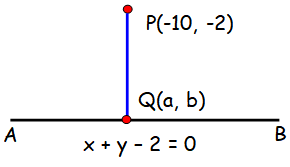EQUATION OF THE LINE WHEN PARALLEL LINE AND SUM OF INTERCEPTS IS GIVEN
Subscribe to our ▶️ YouTube channel 🔴 for the latest videos, updates, and tips.
Question 1 :
Find the equation of a straight line parallel to 2x + 3y = 10 and which is such that the sum of its intercepts on the axes is 15
Solution :
Since the required line is parallel to the line 2x + 3y = 10
Equation of the required line will be in the form
2x + 3y + k = 0
Let us change the above equation to intercept form.
2x + 3y = -k
2x/(-k) + 3y/(-k) = 1
x/(-k/2) + y/(-k/3) = 1
x -intercept = a and y -intercept = b
Sum of intercepts = 15
a + b = 15
(-k/2) + (-k/3) = 15
(-3k - 2k)/6 = 15
-5k/6 = 15
k = -15(6)/5 = -18
2x + 3y - 18 = 0
Hence the equation of the required line is 2x + 3y - 18 = 0.
Question 2 :
Find the length of the perpendicular and the co-ordinates of the foot of the perpendicular from (−10,−2) to the line x + y − 2 = 0
Solution :

The lines PQ and AB are perpendicular to each other.
Equation of AB :
x + y - 2 = 0
Equation of PQ :
x - y + k = 0
The point P (-10, -2) lies on the line PQ.
-10 + 2 + k = 0
k - 8 = 0
k = 8
Equation of PQ is x - y + 8 = 0
By solving the equations of AB and PQ, we get the value of P.
x + y - 2 = 0 ----(1)
x - y + 8 = 0 ----(2)
(1) + (2) ==> 2x + 6 = 0 ==> x = -3
By applying the value of x in (1), we get the value of y.
-3 + y - 2 = 0
-5 + y = 0
y = 5
Hence the required point P (-3, 5)
Length of perpendicular :
= √(x2 - x1)2 + (y2 - y1)2
= √(-3+10)2 + (5+2)2
= √72 + 72
= √98 = 7√2 units
Subscribe to our ▶️ YouTube channel 🔴 for the latest videos, updates, and tips.
Kindly mail your feedback to v4formath@gmail.com
We always appreciate your feedback.
About Us | Contact Us | Privacy Policy
©All rights reserved. onlinemath4all.com
Recent Articles
-
AP Calculus BC Problems with Solutions
Dec 20, 25 10:51 AM
AP Calculus BC Problems with Solutions -
AP Precalculus Problems and Solutions (Part - 1)
Dec 20, 25 10:49 AM
AP Precalculus Problems and Solutions (Part - 1) -
AP Calculus AB Problems with Solutions (Part - 1)
Dec 20, 25 10:49 AM
AP Calculus AB Problems with Solutions (Part - 1)
